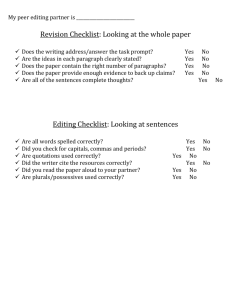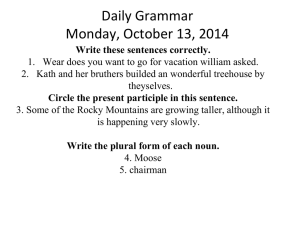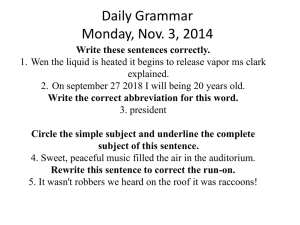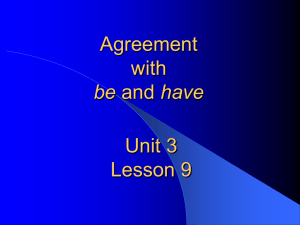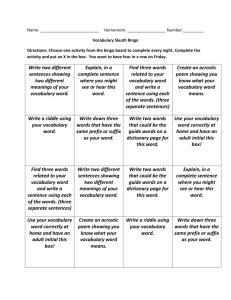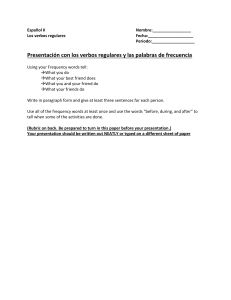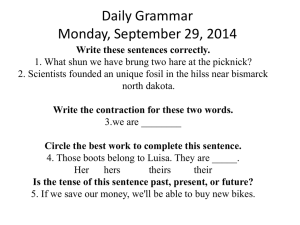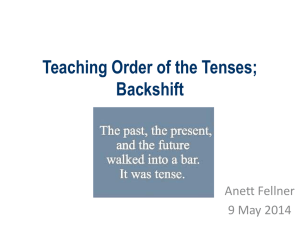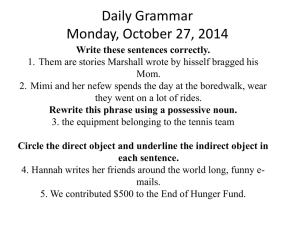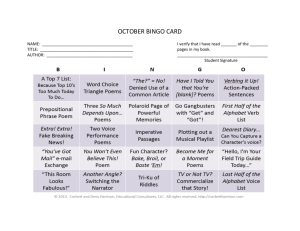Literacy Map Year 1 - Nutgrove Methodist Aided Primary School
advertisement
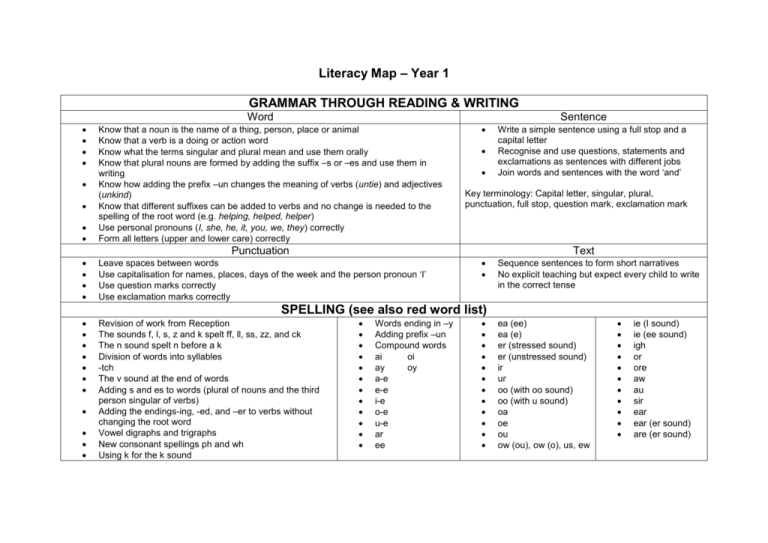
Literacy Map – Year 1 GRAMMAR THROUGH READING & WRITING Word Sentence Know that a noun is the name of a thing, person, place or animal Know that a verb is a doing or action word Know what the terms singular and plural mean and use them orally Know that plural nouns are formed by adding the suffix –s or –es and use them in writing Know how adding the prefix –un changes the meaning of verbs (untie) and adjectives (unkind) Know that different suffixes can be added to verbs and no change is needed to the spelling of the root word (e.g. helping, helped, helper) Use personal pronouns (I, she, he, it, you, we, they) correctly Form all letters (upper and lower care) correctly Write a simple sentence using a full stop and a capital letter Recognise and use questions, statements and exclamations as sentences with different jobs Join words and sentences with the word ‘and’ Key terminology: Capital letter, singular, plural, punctuation, full stop, question mark, exclamation mark Punctuation Text Leave spaces between words Use capitalisation for names, places, days of the week and the person pronoun ‘I’ Use question marks correctly Use exclamation marks correctly Revision of work from Reception The sounds f, l, s, z and k spelt ff, ll, ss, zz, and ck The n sound spelt n before a k Division of words into syllables -tch The v sound at the end of words Adding s and es to words (plural of nouns and the third person singular of verbs) Adding the endings-ing, -ed, and –er to verbs without changing the root word Vowel digraphs and trigraphs New consonant spellings ph and wh Using k for the k sound Sequence sentences to form short narratives No explicit teaching but expect every child to write in the correct tense SPELLING (see also red word list) Words ending in –y Adding prefix –un Compound words ai oi ay oy a-e e-e i-e o-e u-e ar ee ea (ee) ea (e) er (stressed sound) er (unstressed sound) ir ur oo (with oo sound) oo (with u sound) oa oe ou ow (ou), ow (o), us, ew ie (I sound) ie (ee sound) igh or ore aw au sir ear ear (er sound) are (er sound) WRITING COMPOSITION Write sentences by: saying out loud what they are going to write about composing a sentence orally before writing it sequencing sentences to form short narratives re-reading what they have written to check that it makes sense Discuss what they have written with the teacher or other pupils READING COMPREHENSION (see also word reading) HANDWRITING Drawing on what they already know or on background information provided by the teacher Checking that the text makes sense to them as they read and correcting inaccurate reading Discussing the significance of the title and events Making inferences on the basis of what is being said and done Predicting what might happen on the basis of what has been read so far Participate in discussion about what is read to them taking turns and listening to what other say Explain clearly their understanding of what is read to them OTHER ORACY (see whole school objectives) Develop pleasure understanding by: RANGE Listening to and discussing a wide range of poems, stories and nonfiction beyond those they can read independently Being encouraged to link what they read or hear to their own experiences Becoming very familiar with key stories, fairy stories and traditional tales, retelling them and considering their particular characteristics Recognising and joining in with predictable phrases Learning to appreciate rhymes and poems, and to recite some by heart Sit correctly at a table, holding a pencil comfortably and correctly Form lower case letters in the correct direction, starting and finishing at the right place Form capital letters Form digits 0-9 Understand which letters belong to which handwriting ‘families’ (ie. letters that are formed in similar ways) and practise these in reading, motivation to read, vocabulary and listening to and discussing a wide range of poems, stories and nonfiction beyond those they can read independently being encouraged to link what they read or hear to their own experiences becoming very familiar with key stories, fairy stories and traditional tales, retelling them and considering their particular characteristics recognising and joining in with predictable phrases learning to appreciate rhymes and poems and to recite some by heart Read aloud their writing clearly enough BOOKS READ IN CLASS Please see below Literacy Year One Books Read In class: Books read in class Year One Topic Autumn The Tiger who came to tea Judith Kerr Bog Baby Jeanne Willis The Snowy Day Ezra Keats Ooopik Bruce Hiscock Elvis and his pelvis Michael Cox Owl babies Owl who was afraid of the dark. Spring One Toy Boat Randall de Seve Dogger Shirley Hughes Spring Two The Naughty Bus Jan and Jerry Oak Summer One Lila and the secret of rain David and Jude Daly Summer Two The Pirate Cruncher Janey Duddle Autumn One Super Daisy Kes Gray &Nick Sharratt Super hero ABC Bob McLeod Charlie’s superhero underpants Paul Bright & Lee Wildish Super Duck Jez Alborough Autumn Two You choose Nick Sharratt Pippa Goodhart Whatever Next Jill murphy Can’t you sleep little bear? Martin Waddell Peace at last Jill Murphy Harvey Slumfenburgers present Spring One Three billy goats gruff traditional tale (various) Three little pigs traditional tale (various) The true story of three little pigs Jon Scieszka Jack and the beanstalk traditional story (various) Cinderella traditional story (various) Yeh Shen Louie Ai-Ling Spring two Burgler Bill Allan Ahlberg Summer One Summer Two Dictionary Rhyming dictionary
